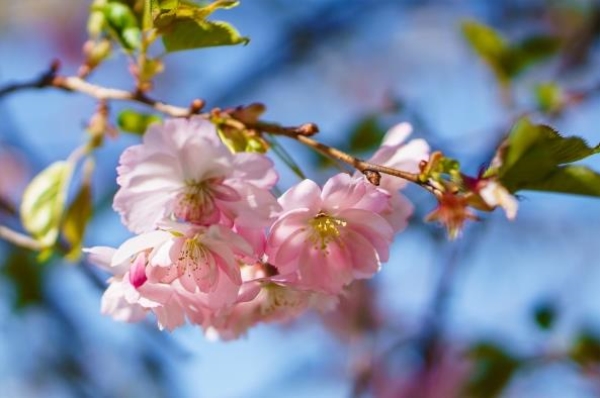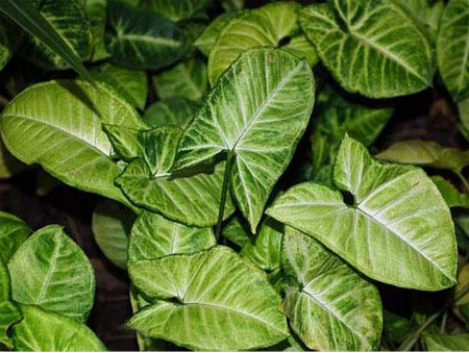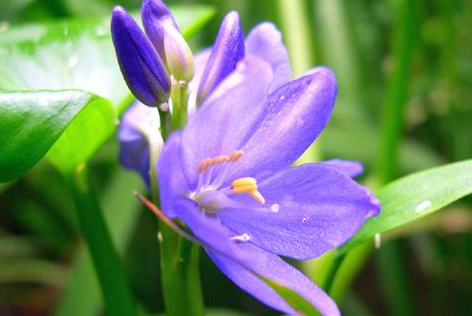The cultivation method of cherry blossoms
Cherry blossoms in potted planting, to timely supplement nutrients, fertilization twice a year, once after the fall of flowers, once for winter fertilizer. And to keep the soil moist, frequent watering, about 8 to 10 days to water, but also to ensure that there is no water at the bottom. Cover the soil with grass to reduce evaporation.

Do you all know about the cherry blossoms? Plant a pot at home!
Cultivation method of cherry grass
Sakura grass is also called primrose, primrose, late-view flower, etc., primrose belongs to perennial herbaceous flowers of primrose family, all leaves are basal, forming rosette leaf cluster, flowers have red, yellow, orange, blue, purple, white and other colors, arranged into umbels, racemes, capitules or single leaves in the scape, corolla funnel-shaped or high-footed saucer-shaped, often cultivated for ornamental cultivation, let's take a look at the cultivation method of Sakura grass together!
The growth habits of cherry grass
Cherry grass likes good drainage, more humus soil, more wet. However, it needs to be dry, avoid strong sun and high temperature in seedling stage, and like warm and ventilated environment. It grows well in sandy loam and clay loam with more humus (pH 5.5 to 6.5). In places where the soil is sticky in the south, it is generally mixed with self-made rotting leaf soil (collected leaves and acidic soil, chicken manure, charcoal powder retting soil). Before mixing, all the original clay blocks must be broken up, otherwise they cannot improve the soil.
The propagation method of cherry grass
Cherry grass is propagated by seeds, but its seed life is short and its germination ability is lost quickly. When seeds harvested in spring are sown in autumn, the germination rate drops by half. Therefore, the harvested seeds should be dried and refrigerated to reduce their metabolic activity and prolong their life. Sowing time should be determined according to the flowering period required, winter flowering can be sown in late spring, spring flowering can be sown in early autumn. The seedlings sown in late spring will soon enter the hot summer, so it is necessary to do a good job of cooling down, otherwise the seedlings will easily die in the hot weather. A small amount of planting can be sown in April. When summer comes, the seedlings have grown up and have strong heat resistance. They can be placed in a cool and ventilated place to spend the summer safely.
Cultivation method of cherry grass
1, soil: cherry grass more favorite rotten clay soil and sandy soil, its PH value can be maintained at 5.5~6.5.
Environment: Cherry grass loves warm, ventilated and humid environments, and can receive astigmatism properly, not suitable for direct sunlight.
Watering: Cherry grass likes a humid environment, but it cannot contact too much water, otherwise it will cause rotten roots.
4, disease: cherry grass is mainly leaf and stem disease, can be used in the early stage of disease with 75% chlorothalonil wettable powder 600~700 times aqueous solution, spray once every 5~7 days, continuous spray several times can control the development of disease.
5, pests: cherry grass pests are mainly red spiders, aphids and other pests, prevention should be the main, spraying 3 to 4 times a year, the first time before flowering, the second time after flowering, the third time in July to August.
The cultivation method of cherry blossoms
Cherry, scientific name Prunus serrulata English name Flowering Cherry alias mountain cherry, Fukushima cherry, green skin cherry family name Rosaceae.
Origin and Habits
Cherry blossoms are produced in the temperate zone of the northern hemisphere, and are most abundant in various types in the mountainous areas of southwest China. The cherry blossoms cultivated in Japan are most famous. Most of them are deciduous shrubs. To climate, soil adapts range is wider. Sun-loving, cold-resistant, drought-resistant, grows well in well-drained soil. Flowering April.
morphological characteristics
Crown ovoid to circular, simple leaves alternate, glandular serrate, flowers solitary on top of branches or 3-6 clusters in umbel or corymbose inflorescences, with leaves at the same time or flowers first, calyx tube campanulate or tubular, cultivars mostly double; fruit red or black, mature in May-June.
Common cultivated species are:
1. Cherry blossom (P.serreulata) is a deciduous tree, 15-25m high, with dark chestnut brown bark and smooth bark. Leaves ovate or ovate-elliptic, margin awned with semi-mature teeth; flowers white or pink, 2.5-4cm in diameter, flowering April.
2. Japanese late cherry (P. lannesiana) is about 10m tall and has light gray bark. Leaves obovate, margin with long awned teeth; flowers single or double, pendulous, pink or subwhite, fragrant, 2-5 aggregated, flowering April.
3. Japanese early cherry (P. subhirtella) is a small tree, about 5m high, with striated bark and old bark. Branchlets brown, leaves obovate to ovate-lanceolate. Flowers pink, 2-2.5cm in diameter, 2-5 umbels, spring flowers before leaves.
4. Cherry (P. sargenti) is 12-20m tall, with brown bark, purple-brown twigs and elliptic-oval leaves. Flowers pink, 2-4 clusters, diameter 3-5cm, flowering 3-4 months.
5. Yunnan cherry (P. cerosoides) is about 10m high, bark brown, twigs purple-brown, leaves elliptic-ovate or obovate, margin with double teeth. Flowers pink to deep red, 2-5 clusters, flowering February-March.
6. Cherry (P. majestica) is about 25m high, bark is light brown, twigs are green, leaves are long elliptic to lanceolate, flowers are pink, flowering period is January to January of the following year.
Culture and cultivation
Cultivate with sowing, grafting, cuttage, etc. Cultivate cherry blossoms by sowing method, pay attention not to dry embryo, should be harvested with sowing or wet sand stratification after the next spring sowing.
Cherry is a deciduous tree. It likes sun, cold tolerance, drought tolerance and salt tolerance. It is suitable for growing in loose, fertile and well-drained plots. It is afraid of wind at flowering stage. It has strong germination and rapid growth.
1. Soil requirements and improvement measures
Cherry blossoms can grow well in sandy loam and clay loam with more humus (pH 5.5 to 6.5). In the south, where the soil is sticky, it is generally mixed with self-made rotten leaf soil (collected leaves and acidic soil, chicken manure, charcoal powder retting soil). Note that all the original clay blocks must be broken before mixing, otherwise it will not play a role in soil improvement. In the underground water table less than 1 meter of the place to adopt high-planting method, that is, the entire planting hole after leveling, and then in the above pile of soil seedlings. Alkaline soil in the north, need to apply sulfur powder or ferrous sulfate to adjust the pH value to about 6. 2 grams of sulfur powder per square meter, valid for 1 to 2 years, and measured annually to make the pH value not exceed 7. Cherry, dye well Yoshino and other varieties of tree trunk straight, tree body larger, is a strong positive species, requiring shelter from the sun, ventilation and light transmission. When planting in patches, make sure that each tree receives sunlight.
II. Planting measures
Planting time in early spring soil thaw immediately after planting, usually in February and March. Planting method: prepare the soil carefully before planting. For planting on flat ground, holes with a diameter of 1 meter and a depth of 0.8 meters can be dug. Fill the hole with about half of the improved soil, put the seedlings in the center of the hole, so that the roots of the seedlings extend in all directions. After a small amount of soil filling, slightly upward seedlings, so that the root system fully extended, and then lightly tread. Seedling planting depth to make the uppermost seedling roots 5 cm from the ground. After planting, make a ponding nest, and fully irrigate, and finally use bamboo chips that are almost as high as seedlings to prevent wind blowing down.
III. Management measures
After planting, the seedlings are vulnerable to drought. In addition to full irrigation at planting, irrigate once every 8 to 10 days to keep the soil moist but without ponding. After irrigation, loosen the soil in time. It is best to cover the surface with grass to reduce water evaporation. Within 2 to 3 years after planting, straw can be wrapped to prevent drying of the trunk. However, after 2 to 3 years, the seedlings grow new roots and gradually increase their adaptability to the environment, so there is no need to pack grass again. Growing period management Cherry blossoms are fertilized twice a year, with acid fertilizer as the best. One time is winter fertilizer, applying organic fertilizer such as bean cake, chicken manure and decomposed fertilizer in winter or early spring; the other time is after flower drop, applying quick-acting fertilizer such as ammonium sulfate, ferrous sulfate and calcium superphosphate. Generally large cherry tree fertilization, can take the method of hole application, that is, in the crown: the edge of the positive projection line, dig a depth of about 10 cm circular groove, fertilizer application. This method is not only simple but also beneficial to root absorption. Later, with the growth of trees, the diameter and depth of the circular groove for fertilization will increase. Cherry root system distribution shallow, requires good drainage and ventilation, so in the tree around the root system distribution range, avoid people, animals, vehicles solid soil. Pedestrian trampling will weaken the tree, shorten its life span, and even cause root rot and death. Pruning and maintenance pruning is mainly to cut off withered branches, excessive branches, overlapping branches and diseased branches. In addition, when many branches grow on the trunk of a large cherry tree, a number of strong branches should be retained, and the rest should be cut off from the base to facilitate ventilation and light transmission. After pruning, the branches should be disinfected with medicine in time to prevent the invasion of germs after rain, resulting in decay. Cherry by long-term sun exposure, bark easy to aging damage, resulting in decay, should be removed in time and disinfection. After that, the rotten parts were bandaged with decayed leaf soil and charcoal powder to promote their normal physiological functions.
IV. Pest control
Gummy moths drill into tree trunks to lay eggs. You can dig out eggs with sharp knives, improve soil and strengthen water and fertilizer management. Rhizobia A disease in which the roots of a tree fail to grow properly and the tree is not healthy no matter how much fertilizer is applied. To remove the tumor in time, soil disinfection treatment, the use of rotten leaf soil, charcoal powder and microorganisms to improve the soil. Aphids, red spiders, scale insects these diseases and insect pests should be mainly prevented. Spray 3 to 4 times a year, the first time before flowering, the second time after flowering, and the third time in July to August.
application
Cherry blossom is an important flowering tree species, which can be planted in large areas to create a "flower sea" landscape. 35 into clusters dotted in the green to form a brocade group, but also can be planted alone to form "a little red in the green" painting meaning. Cherry can also be used as street trees, hedges or bonsai production.
- Prev

What details should be paid attention to in indoor breeding of white butterflies?
1. Avoid placing white butterfly potted plants indoors where children can reach them. Children are always curious about strange things, especially when they are young, they like to eat casually. If children accidentally eat the leaves of white butterflies in the course of playing, it is very likely to cause life danger.
- Next

The Propagation method of Rain long Flower
Ramet propagation is generally carried out in early spring. First take out the mother plant, shake off the excess soil, separate the roots with a knife, and divide them into two or more plants, each with complete roots and properly trimmed roots and leaves. Soak the new strain in chlorothalonil solution, then dry it in a basin and keep it in a cool place.
Related
- Fuxing push coffee new agricultural production and marketing class: lack of small-scale processing plants
- Jujube rice field leisure farm deep ploughing Yilan for five years to create a space for organic food and play
- Nongyu Farm-A trial of organic papaya for brave women with advanced technology
- Four points for attention in the prevention and control of diseases and insect pests of edible fungi
- How to add nutrient solution to Edible Fungi
- Is there any good way to control edible fungus mites?
- Open Inoculation Technology of Edible Fungi
- Is there any clever way to use fertilizer for edible fungus in winter?
- What agents are used to kill the pathogens of edible fungi in the mushroom shed?
- Rapid drying of Edible Fungi

